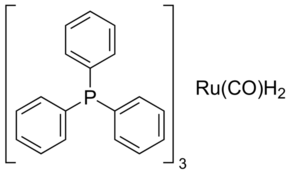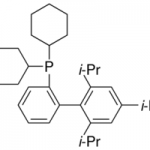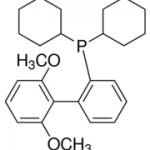Carbonyldihydrotris(triphenylphosphine)ruthenium CAS#: 25360-32-1; ChemWhat Code: 34000
Identification
| Product Name | Carbonyldihydrotris(triphenylphosphine)ruthenium |
| IUPAC Name | formaldehyde;ruthenium dihydride;triphenylphosphane |
| Molecular Structure |  |
| CAS Registry Number | 25360-32-1 |
| Synonyms | carbonyl bis(hydrido)tris(triphenylphosphine)ruthenium(II), carbonyl(dihydrido)tris(triphenylphosphine)ruthenium(II), carbonyl(dihydro)tris(triphenylphosphine)ruthenium(II), carbonyl(dihydrido)tris(triphenylphosphine)ruthenium, carbonyldihydridotris(triphenylphosphine)ruthenium, Ru(PPh3)3(CO)H2, [RuH2(CO)(PPh3)3] CAS No: 25360-32-1 |
| Molecular Formula | C55H47OP3Rh |
| Molecular Weight | 919.788 |
| InChI | InChI=1S/3C18H15P.CO.Rh.2H/c31-4-10-16(11-5-1)19(17-12-6-2-7-13-17)18-14-8-3-9-15-18;1-2;;;/h31-15H;;;; |
| InChI Key | WBIIBWMSHZJFCB-UHFFFAOYSA-N |
| Canonical SMILES | [C-]#[O+].c1ccc(cc1)P(c2ccccc2)c3ccccc3.c1ccc(cc1)P(c2ccccc2)c3ccccc3.c1ccc(cc1)P(c2ccccc2)c3ccccc3.[RhH2] |
| Patent Information | ||
| Patent ID | Title | Publication Date |
| WO2015/109451 | SYNTHESIS OF COMPOUNDS CONTAINING 8-OXA-3-AZABICYCLO (3.2.1)OCTANE RING | 2015 |
| WO2014/198658 | RUTHENIUM- OR OSMIUM-BASED COMPLEX CATALYSTS | 2014 |
| US2004/92759 | Process for making haloalkylalkoxysilanes | 2004 |
| EP1176136 | PROCESS FOR PRODUCING FUMARIC ESTER | 2002 |
Physical Data
| Appearance | Grey white to dark gray crystalline powder |
| Solubility | Insoluble in water. |
| Sensitivity | Moisture Sensitive |
| Comment (Solubility (MCS)) |
| sparingly sol. in CH2Cl2 and CHCl3; slightly sol. in C6H6; |
Spectra
| Description (NMR Spectroscopy) | Nucleus (NMR Spectroscopy) | Solvents (NMR Spectroscopy) | Frequency (NMR Spectroscopy), MHz |
| Chemical shifts | 1H | benzene-d6 | 500 |
| Chemical shifts | 31P | benzene-d6 | 202 |
| Chemical shifts, Spectrum | 31P | benzene-d6 | |
| Chemical shifts, Spectrum | 1H | benzene-d6 | 600 |
| Chemical shifts, Spectrum | 1H | (2)H8-toluene | 400 |
| Chemical shifts | 1H | chloroform-d1 | 400 |
| 2D-NMR, Spectrum | 1H, 13C | benzene-d6 | |
| Spectrum | 1H | C6D5CD3=toluene-d8 | |
| 1H | CDCl3 | ||
| 1H | not given |
| Description (IR Spectroscopy) | Solvent (IR Spectroscopy) | Comment (IR Spectroscopy) |
| Spectrum | toluene | 14.85 – 54.85 |
| Bands, Spectrum | benzene-d6 | |
| Intensity of IR bands, Bands, Spectrum | ||
| Bands | neat (no solvent) | 1867 cm**-1 – 1960 cm**-1 |
| Bands | potassium bromide | |
| Bands | not given | |
| Bands | KBr | 1935 cm**-1 – 1960 cm**-1 |
| Bands | nujol | 1900 cm**-1 – 1960 cm**-1 |
| Description (UV/VIS Spectroscopy) | Solvent (UV/VIS Spectroscopy) |
| Spectrum | chloroform |
Route of Synthesis (ROS)
| Conditions | Yield |
| In benzene at 70℃; for 12h; Inert atmosphere; Schlenk technique; Experimental Procedure 2.1. Substrate preparation and reaction conditions General procedure: Complexes A, B and C were prepared under similar condi-tions. The complex A was prepared as follows: The mixtureof RuH2(CO)(PPh3)3, imine 13 and triethoxyvinylsilane in ben-zene was prepared under nitrogen atmosphere in a Schlenk tube (Ru/imine/silane = 1/3/3) and heated at 70C for 12 h. After cool-ing, the reaction mixture was concentrated in vacuo and to theresi due hexane was added to precipitate the complex. The pre-cipitates were washed with hexane 2 times to give pale yellow powders. The obtained complex was applied to NMR, FAB-MS andIR analysis. Complex B was prepared by the reaction at 110C for 12 h. | 95% |
Safety and Hazards
| Pictogram(s) |  |
| Signal | Warning |
| GHS Hazard Statements | H302 (97.78%): Harmful if swallowed [Warning Acute toxicity, oral] H312 (84.44%): Harmful in contact with skin [Warning Acute toxicity, dermal] H315 (13.33%): Causes skin irritation [Warning Skin corrosion/irritation] H319 (13.33%): Causes serious eye irritation [Warning Serious eye damage/eye irritation] H332 (84.44%): Harmful if inhaled [Warning Acute toxicity, inhalation] H335 (13.33%): May cause respiratory irritation [Warning Specific target organ toxicity, single exposure; Respiratory tract irritation] Information may vary between notifications depending on impurities, additives, and other factors. |
| Precautionary Statement Codes | P261, P264, P270, P271, P280, P301+P312, P302+P352, P304+P312, P304+P340, P305+P351+P338, P312, P321, P322, P330, P332+P313, P337+P313, P362, P363, P403+P233, P405, and P501 (The corresponding statement to each P-code can be found at the?GHS Classification?page.) |
Other Data
| Transportation | NONH for all modes of transport |
| Under the room temperature and away from light | |
| HS Code | 284390 |
| Storage | Stored at low temperature after vacuum packaging, can not be operated in air. |
| Shelf Life | 2 years |
| Market Price | USD |
| Druglikeness | |
| Lipinski rules component | |
| Molecular Weight | 917.969 |
| HBA | 1 |
| HBD | 0 |
| Matching Lipinski Rules | 2 |
| Veber rules component | |
| Polar Surface Area (PSA) | 0 |
| Rotatable Bond (RotB) | 12 |
| Matching Veber Rules | 1 |
| Bioactivity |
| In vitro: Efficacy |
| Quantitative Results |
| Quantitative Results | ||
| 1?of?1 | Results | physiological behaviour discussed |
| Use Pattern |
| Catalyst for converting 1,4-alkanediol to pyrrole; Catalyst for oxidation of primary alcohol to methyl ester; Catalyst for rearrangement of oxime to amide; Catalyst for C-C coupling by directional C-H activation; Catalyst for cyclopentane cyclization. |
Related Chemicals
Buy Reagent | |
| No reagent supplier? | Send quick inquiry to ChemWhat |
| Want to be listed here as a reagent supplier? (Paid service) | Click here to contact ChemWhat |
Approved Manufacturers | |
| Warshel Chemical Ltd | http://www.warshel.com/ |
| Want to be listed as an approved manufacturer (Requires approvement)? | Please download and fill out this form and send back to approved-manufacturers@chemwhat.com |
Other Suppliers | |
| Watson International Limited | Visit Watson Official Website |
Contact Us for Other Help | |
| Contact us for other information or services | Click here to contact ChemWhat |




